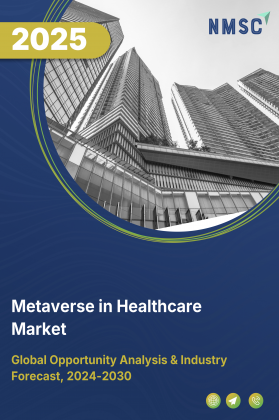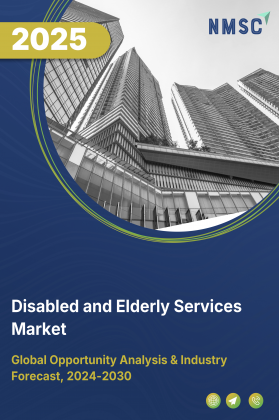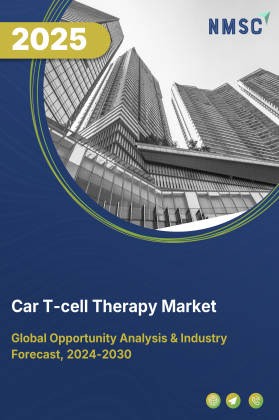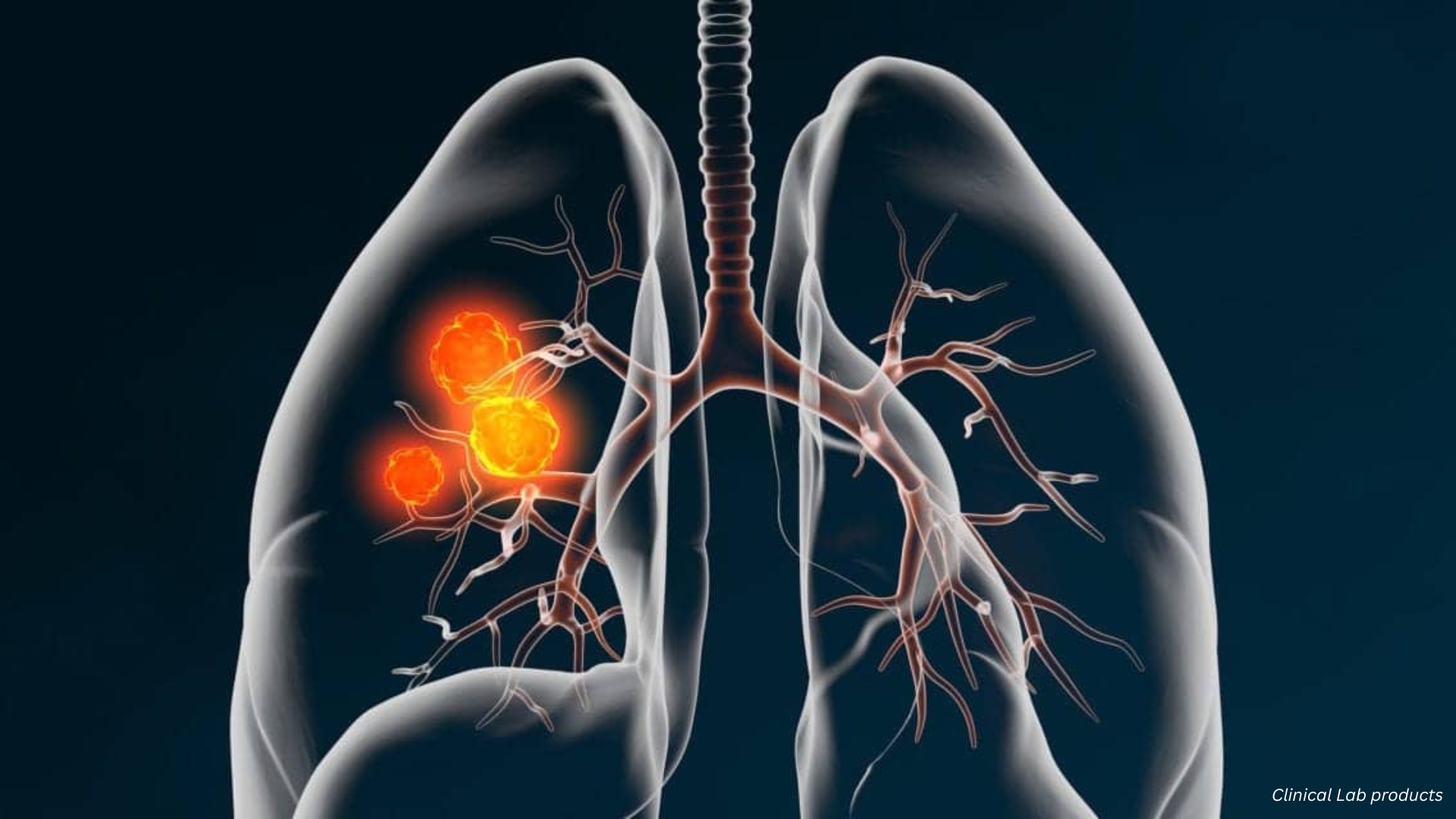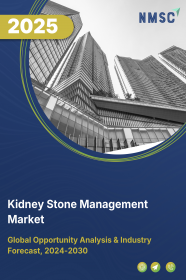
Kidney Stone Management Market By Product Type (Devices, Disposables, and Software Solutions), By Stone Type (Calcium Stones, Calcium Oxalate, and Others), By Technological Integration (Conventional Technologies and Advanced Technologies), By Treatment Type (Non-Invasive and Minimally Invasive), and By End User (Hospitals, Surgical Centers (ASCs), Urology Clinics, Diagnostic Centers, and Home Care Settings) – Global Opportunity Analysis and Industry Forecast 2025–2030
Industry Overview
The global Kidney Stone Management Market size was valued at USD 2.93 billion in 2024, and is expected to be valued at USD 3.13 billion by the end of 2025. The industry is projected to grow, hitting USD 4.13 billion by 2030, with a CAGR of 5.7% between 2025 and 2030.
The market is witnessing significant growth driven by the rising incidence and recurrence of kidney stones globally. As more people are affected by lifestyle factors and aging, there is an increasing demand for advanced and minimally invasive treatment solutions.
Technological advancements, including improvements in ureteroscopy, percutaneous nephrolithotomy, and extracorporeal shock wave lithotripsy, are enhancing treatment outcomes and reducing recovery times. The aging population further fuels the demand for specialized care, as older adults are more susceptible to kidney stones.
However, challenges such as high treatment costs and limited access to care in low-income regions hinder market growth. Opportunities exist in expanding non-invasive and office-based treatments, which offer quicker recovery and fewer complications. The market is also characterized by strong competition among key players, who focus on innovation and regional expansion to meet the growing demand.
Despite hurdles like economic instability and a shortage of healthcare professionals in some areas, the sector continues to evolve with technological advancements and increasing healthcare access worldwide.
Rising Incidence and Recurrence of Kidney Stones Driving the Market Growth
The growing number of people affected by renal stones worldwide continues to strengthen the demand for advanced treatment solutions. Around 10–15% of the global population is impacted, largely due to lifestyle-related factors such as obesity, poor hydration, and high-sodium diets.
In the U.S. alone, more than 500,000 emergency room visits occur each year due to kidney stones, and over 50% of these patients experience recurrence within five years, as reported by the National Kidney Foundation.
In India, around 12% of the population suffers from kidney stones, with nearly half at risk of kidney function loss if left untreated. This growing burden is increasing the need for reliable devices and procedures, including non-invasive options like extracorporeal shock wave lithotripsy (ESWL) and innovative tools.
Advancement in Minimally Invasive Procedures Enhancing Treatment Efficiency
Progress in minimally invasive technologies is reshaping the kidney stone management market trends. Techniques such as ureteroscopy, percutaneous nephrolithotomy (PCNL), and ESWL are being preferred due to their ability to reduce hospital stays, recovery time, and complications. Newer systems offer improved visualization and control during procedures.
Additionally, the development of mini-PCNL using smaller 14–20 Fr sheaths allow for less bleeding and eliminates the need for drainage tubes in most cases. Devices like Olympus’s Soltive Laser System and Dornier MedTech’s SmartLitho are also improving clinical outcomes and accelerating the shift toward these modern techniques, which encourages broader adoption by healthcare facilities.
Aging Population is Driving the Demand for Specialized Kidney Stone Management Solutions
The rising elderly population is another key factor contributing to the kidney stone management market growth. Older adults are more likely to develop kidney stones due to age-related metabolic changes and chronic conditions such as diabetes.
WHO projects the global population aged 65 and above to reach 1.4 billion by 2030, intensifying the need for effective diagnosis and treatment. On the other hand, global warming and climate change are expected to further increase the incidence of nephrolithiasis in the U.S. by 30% by the year 2050, especially in warmer regions. These trends support the rising demand for advanced diagnostics and minimally invasive treatment options.
High Cost of Treatment and Limited Access to Healthcare Hinders Market Expansion in Developing and Underdeveloped Countries
The kidney stone management sector faces a major challenge due to the high cost of advanced treatments and limited access in many parts of the world. Procedures that use technologies such as laser lithotripsy or robotic systems are often expensive and require trained medical staff.
In many low- and middle-income countries, patients cannot afford these treatments or do not have access to specialized hospitals. The cost becomes even higher for those who need repeat treatments due to recurring kidney stones. This financial burden and lack of access reduce the use of modern treatment methods and slow down the overall growth potential of the market.
Adoption of Non-Invasive and Office-Based Treatments Creates Future Market Opportunities
A major kidney stone management market opportunity lies in the shift toward non-invasive and office-based treatment options. Traditional open surgeries often involve longer hospital stays, more pain, and slower recovery. In contrast, non-invasive methods such as extracorporeal shock wave lithotripsy (ESWL), laser lithotripsy, and certain types of ureteroscopy offer quicker recovery, less discomfort, and fewer complications.
For instance, SonoMotion launched one of the first non-invasive FDA approved ultrasound system Stone Clear, designed to facilitate the passage of residual kidney stone fragments post-lithotripsy. The use focused ultrasound to help pass remaining kidney stone fragments after treatment, shows how non-invasive solutions are improving patient outcomes and expanding access to medical care.
These procedures can often be done in outpatient or office-based settings, reducing the need for hospitalization. Also, another key player Calyxo received FDA clearance for its redesigned CVAC System in March 2024, an all-in-one device integrating ureteroscopy, laser lithotripsy, irrigation, and aspiration.
Market Segmentation and Scope of the Study
The kidney stone management market report is categorized based on product type, stone type, technological integration, diagnostic methods, treatment type, patient demographics, end-users, and regions. By product type, the market is segmented into devices, disposables, and software solutions. By stone type, the market is segmented into calcium stones, uric acid stones, struvite stones, cystine stones, and other types. In terms of technological integration, the market is divided into conventional technologies and advanced technologies. On the basis of diagnostic methods, the market is segmented into abdominal X-ray, computed tomography (CT), ultrasound, abdominal MRI, intravenous pyelography (IVP), and other diagnostic techniques. By treatment type, the market covers non-invasive treatments, minimally invasive treatments surgical treatments, and medical management. Based on patient demographics, the market is categorized into pediatric (0-18 years), adult (19-64 years), and geriatric (65+ years) age groups. The end-users of kidney stone management solutions include hospitals, ambulatory surgical centers (ASCs), urology clinics, diagnostic centers, and home care settings. The market is further analyzed by regions, covering key markets in North America, Europe, Asia-Pacific (APAC), and the Rest of the World (RoW).
Geographical Analysis
North America leads the global kidney stone management market share, driven by a high prevalence of kidney stones. According to the National Health and Nutrition Examination Survey (NHANES), the prevalence of kidney stones in the U.S. is approximately 11% among men and 6% among women.
Favourable reimbursement policies, such as Medicare covering 80% of lithotripsy costs, and high patient awareness further support demand. For instance, innovations like Boston Scientific’s introduction of the LithoVue Elite in 2023 with the ability to monitor intrarenal pressure in real-time during ureteroscopy procedures demonstrate significant advancements in safety, enhancing urological technologies for treatment.
Europe is a significant sector, with countries like Germany, the U.K., and France leading due to a kidney stone prevalence. Robust healthcare systems and increasing adoption of advanced technologies, such as laser lithotripsy and robotic-assisted surgeries, drive the market growth.
For instance, Siemens Healthineers introduced Acuson Sequoia 3.5, a major software and hardware update to the Acuson Sequoia ultrasound system that leverages AI-powered features for improved workflow and efficiency to enhance clinical performance.
With AI-based detection, labelling, and measurements, the doctor can focus on the patient who may be experiencing significant pain or discomfort due to a range of potential causes, from kidney stones and digestive issues to cancerous tumors.
Asia-Pacific is experiencing rapid growth, fuelled by a high prevalence of kidney stones, in countries like India, due to poor dietary habits, tropical climates, and obesity. Uric acid stones cases are common in countries in India and Pakistan, with higher rates in urban areas.
Improving healthcare infrastructure, rising disposable incomes, and government initiatives like India’s Ayushman Bharat scheme enhance access to urological care. For instance, acquisition of ESWL machines by Osmania General Hospital in India, for cost-effective kidney stones removal in October 2024 boosts the access to affordable treatment among the population. However, limited awareness in rural areas and high costs of imported devices, ranging from USD 3,000–5,000 for laser lithotripsy, restrict growth.
RoW that comprises, Latin America, the Middle East, and Africa are emerging markets, with Brazil, Mexico, Saudi Arabia, UAE, and South Africa as key contributors, driven by a kidney stone prevalence of 10.5% in Latin America and up to 8.17% in Saudi Arabia, as per the 2023 ISN Atlas.
In Latin America, the highest proportions of deaths attributed to CKD are found in Mexico (9.8%), El Salvador (10.2%), and Nicaragua (11.9%). In the Middle East, investments like Saudi Vision 2030 and a 10% increase in UAE’s robotic-assisted surgeries (2024) drive growth.
South Africa benefits from the availability of affordable lithotripters, particularly from companies like Richard Wolf GmbH. Challenges include economic instability in Latin America, limited access in low-income African countries, and a shortage of specialists across these regions.
Key Players and their Strategic Developments in the Industry
The kidney stone management industry is fiercely competitive, with major players like Boston Scientific, Olympus Corporation, Cook Medical, Medtronic, Karl Storz, Dornier MedTech, Siemens Healthineers, and Richard Wolf GmbH leading through innovation and strategic expansion.
Boston Scientific drives the market with its LithoVue Elite ureteroscope, while Olympus’s Soltive Laser System enhances lithotripsy precision. Medtronic’s HemoClear system and Dornier MedTech’s SmartLitho strengthen their offerings in the market.
Similarly, Siemens Healthineers advances diagnostics with 3D imaging platforms, and Cook Medical expands access with cost-effective stone retrieval devices. Conversely, Karl Storz’s partnerships in China for flexible ureteroscopes target Asia-Pacific expansion.
Companies employ strategies like AI-integrated imaging, robotic-assisted systems, and hospital collaborations to gain market share. While smaller regional manufacturers in Asia-Pacific offer affordable alternatives. The landscape is shaped by technological advancements, cost-optimization efforts, and penetration into high-growth regions, despite challenges like regulatory complexities and high R&D costs.
Key Benefits
-
The report provides quantitative analysis and estimations of the kidney stone management industry from 2025 to 2030, which assists in identifying the prevailing market opportunities.
-
The study comprises a deep dive analysis of the current and future kidney stone management market trends to depict prevalent investment pockets in the sector.
-
Information related to key drivers, restraints, opportunities, and their impact on the industry is provided in the report.
-
Competitive analysis of the key players, along with their market share, is provided in the report.
-
SWOT analysis and Porter's Five Forces model are elaborated in the study.
-
Value chain analysis in the market study provides a clear picture of the roles of stakeholders.
Kidney Stone Management Market Key Segments
By Product Type
-
Devices
-
Lithotripters
-
Extracorporeal Shock Wave Lithotripsy (ESWL) Devices
-
Intracorporeal Lithotripsy Devices
-
-
Ureteroscopes
-
Flexible Ureteroscopes
-
Semi-Rigid Ureteroscopess
-
Disposable Ureteroscopes
-
-
Stone Retrieval Devices
-
Baskets
-
Graspers
-
Forceps
-
-
Stents
-
Ureteral Stents
-
Nephrostomy Tubes
-
-
Imaging Systems
-
Ultrasound Systems
-
X-Ray Systems
-
CT Scanners
-
MRI Systems
-
-
Holmium Lasers
-
Nephroscopes
-
-
Disposables
-
Guidewires
-
Catheters
-
Access Sheaths
-
Drainage Bags
-
Retrieval Coils
-
-
Software Solutions
-
Treatment Planning Software
-
Imaging Integration Software
-
Patient Monitoring Systems
-
By Stone Type
-
Calcium Stones
-
Calcium Oxalate
-
Calcium Phosphate
-
-
Uric Acid Stones
-
Struvite Stones
-
Cystine Stones
-
Others
By Technological Integration
-
Conventional Technologies
-
Advanced Technologies
-
AI-Integrated Imaging Systems
-
Robotic-Assisted Surgery Systems
-
3D Printing for Stents and Tools
-
Telemedicine for Follow-Up Care
-
Wearable Devices for Monitoring
-
By Diagnostics Method
-
Abdominal X-Ray
-
Computed Tomography (CT)
-
Ultrasound
-
Abdominal MRI
-
Intravenous Pyelography (IVP)
-
Others
By Treatment Type
-
Non-Invasive
-
Minimally Invasive
-
Ureteroscopy (URS)
-
Percutaneous Nephrolithotomy (PCNL)
-
Retrograde Intrarenal Surgery (RIRS)
-
Others
-
-
Surgical
-
Open Surgery
-
Laparoscopic Surgery
-
-
Medical Management
-
Pharmacological Therapy
-
Dietary Supplements
-
Medications
-
By Patient Demographics
-
Pediatric (0-18 years)
-
Adult (19-64 years)
-
Geriatric (65+ years)
By End-User
-
Hospitals
-
Ambulatory Surgical Centers (ASCs)
-
Urology Clinics
-
Diagnostic Centers
-
Home Care Settings
Key Players
-
Mayo Clinic
-
Becton, Dickinson and Company
-
Olympus Corporation
-
Boston Scientific Corporation
-
Cook Medical Inc.
-
KARL STORZ SE & Co. KG
-
Richard Wolf GmbH
-
Dornier MedTech GmbH
-
DirexGroup
-
Elmed Medical Systems
-
Medispec Ltd.
-
E.M.S. Electro Medical Systems S.A.
-
Coloplast A/S
-
Siemens Healthineers
-
Nipro Corporation
REPORT SCOPE AND SEGMENTATION
|
Parameters |
Details |
|
Market Size in 2025 |
USD 3.13 Billion |
|
Revenue Forecast in 2030 |
USD 4.13 Billion |
|
Growth Rate |
CAGR of 5.7% from 2025 to 2030 |
|
Analysis Period |
2024–2030 |
|
Base Year Considered |
2024 |
|
Forecast Period |
2025–2030 |
|
Market Size Estimation |
Billion (USD) |
|
Growth Factors |
|
|
Countries Covered |
28 |
|
Companies Profiled |
15 |
|
Market Share |
Available for 10 companies |
|
Customization Scope |
Free customization (equivalent up to 80 working hours of analysts) after purchase. Addition or alteration to country, regional, and segment scope. |
|
Pricing and Purchase Options |
Avail customized purchase options to meet your exact research needs. |

















 Speak to Our Analyst
Speak to Our Analyst



